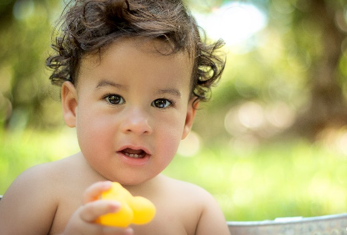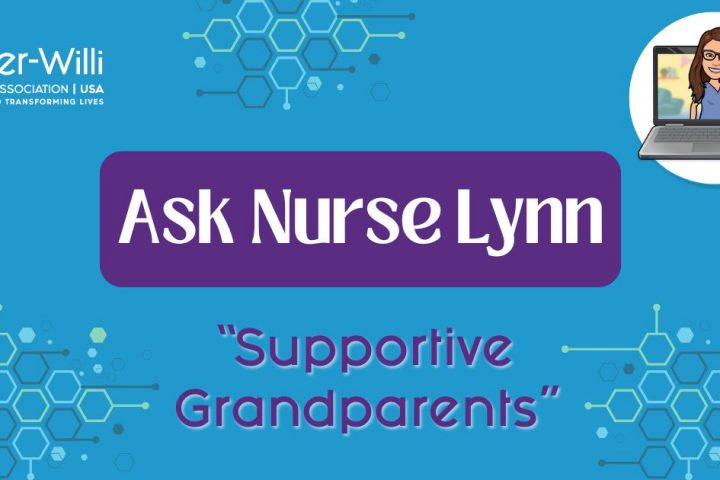by Kathy Clark, Medical Coordinator
Body temperature regulation is a challenge for people with PWS. They can easily become overheated, especially during infancy and childhood. Here are some great ideas to help you be safe when the thermometer rises. Outdoor activities should be planned for the cooler mornings, rather than sunny afternoons or the heat of early evenings. Seek shade or create your own with an umbrella. Provide a wide brimmed hat for sun protection. Fair skin always needs good SPF protection, so avoiding direct sun because of the risk of overheating helps with two important health issues. For schoolchildren, make sure the IEP includes practical plans for recess on hot days – shaded play area, wear a hat, provide low energy activities, and supervision by an adult watching for signs of an overheated child. We recommend outdoor time for all children and prevention and preparation can mean that your child will never suffer from a heat emergency.
Always travel with a frozen water bottle; metal bottles travel well. Keep one in your freezer and grab it whenever you go out, even for a short trip. It can serve as a drink and as a cold pack. Leave it on a car seat and let it defrost and cool the seat.
Cold drinks or frozen drinks (Slurpees) can help reduce body temperature internally. In a crisis, don’t worry about the sugar content of an ice-cold beverage. Avoid caffeine if possible. However, don’t overuse frozen treats during hot weather, or your child may come to expect these. Zoku slush makers will allow you to make your slushy treats out of preferred liquids.
Babies should sleep in an air-conditioned room with good air circulation. If you don’t have central air conditioning, a window unit might be covered as a medical necessity – check with your insurance plan.
Don’t expect any person with PWS to do well in a hot car – let the car cool off. Park in the shade, open the windows and maximize the A/C before loading in your most precious cargo.
Fans help cool the skin, which is a highly effective way to lower temperature rapidly. Invest in a small battery powered fan for travel, and a larger fan for at home. Wet skin plus moving air is a very effective treatment for the heat.
Travel with a small insulated cooler filled with thin wet towels, a water bottle, and blue ice packs. The cooler can be fully packed and kept in the freezer between trips.
Athletes use technology to keep cool, so check out the sporting goods aisles for the latest items – neck bandanas filled with gels that cool; Frogger towels, a shammy which stays cool when wet.
Gauze blankets, commonly used for swaddling babies, are very thin cotton fabrics, perfect for draping over a stroller. Dip them in water first for an added cooling effect. Fold the blanket, dampen it, and store it frozen in a zip lock bag.
Cooling gel pads are available – marketed for pet owners with hot furry pets– and are quite effective for short term use. These come in a variety of sizes. Most of these gel pads rely on pressure to active cooling, and some rely on water to be effective. There are also cooling gel pads made to fit into car seats.
Duct tube devices can direct the front seat AC vents directly to the child in the back seat – such as The Noggle.
Construction workers need to stay cool too so technology has been developed for the people who help get our roads repaired. Cooling vests can make extended time outdoors safer: polarproducts.com and ergodyne.com/cooling.html – available in child sizes.
There are many small battery powered fans that include a spray water bottle, the ideal combination for cooling – air movement over damp skin.
What child doesn’t enjoy a wading pool or a sprinkler? Keeping your hose in the sun will “warm” the water so that the pool isn’t too cold – just make sure the pool is in the shade before filling it up.
What are serious heat problems?
Heat exhaustion is an urgent situation, often with heavy sweating, rapid pulse, dizziness, fatigue, cool moist skin with goose bumps (despite the heat), muscle cramps, nausea and headache. This is most commonly seen after intense activity, such as sports. Many of these symptoms may not occur in persons with PWS – so look for red cheeks, exhaustion, and fatigue.
Rapidly cool an overheated person. Get into a cool place, at least into the shade, and make sure there is good air circulation or turn on a fan. Remove most clothing; wet the skin to bring down the body temperature. The largest blood vessels are on the sides of the neck, underarms, and the groin. Placing cold wet towels in these important locations will rapidly cool the blood. Be careful – ice must be wrapped to avoid damage to the skin. Encourage sips of the coldest beverage available – regardless of whether it has sugar – the goal when a person overheats is maximum hydration.
Heat stroke is an emergency – sweating stops and confusion or collapse can occur. Call 911 and continue all efforts to reduce body temperature as rapidly as possible.
Enjoy the summer
Please don’t let worrying about the heat limit your outdoor fun or keep you from time outdoors. Children with PWS should attend their sibling’s soccer games, go to the beach, take a summer hike, and play in the back yard. Spending time in nature and being physically active are essential to physical and mental health, so don’t let fear keep your family indoors. It is all about pacing, preparing, and planning.





 Jennifer Bolander has been serving as a Special Education Specialist for PWSA (USA) since October of 2015. She is a graduate of John Carroll University and lives in Ohio with her husband Brad and daughters Kate (17), and Sophia (13) who was born with PWS.
Jennifer Bolander has been serving as a Special Education Specialist for PWSA (USA) since October of 2015. She is a graduate of John Carroll University and lives in Ohio with her husband Brad and daughters Kate (17), and Sophia (13) who was born with PWS. Perry A. Zirkel has written more than 1,500 publications on various aspects of school law, with an emphasis on legal issues in special education. He writes a regular column for NAESP’s Principal magazine and NASP’s Communiqué newsletter, and he did so previously for Phi Delta Kappan and Teaching Exceptional Children.
Perry A. Zirkel has written more than 1,500 publications on various aspects of school law, with an emphasis on legal issues in special education. He writes a regular column for NAESP’s Principal magazine and NASP’s Communiqué newsletter, and he did so previously for Phi Delta Kappan and Teaching Exceptional Children. Evan has worked with the Prader-Willi Syndrome Association (USA) since 2007 primarily as a Crisis Intervention and Family Support Counselor. Evans works with parents and schools to foster strong collaborative relationships and appropriate educational environments for students with PWS.
Evan has worked with the Prader-Willi Syndrome Association (USA) since 2007 primarily as a Crisis Intervention and Family Support Counselor. Evans works with parents and schools to foster strong collaborative relationships and appropriate educational environments for students with PWS. Dr. Amy McTighe is the PWS Program Manager and Inpatient Teacher at the Center for Prader-Willi Syndrome at the Children’s Institute of Pittsburgh. She graduated from Duquesne University receiving her Bachelor’s and Master’s degree in Education with a focus on elementary education, special education, and language arts.
Dr. Amy McTighe is the PWS Program Manager and Inpatient Teacher at the Center for Prader-Willi Syndrome at the Children’s Institute of Pittsburgh. She graduated from Duquesne University receiving her Bachelor’s and Master’s degree in Education with a focus on elementary education, special education, and language arts. Staci Zimmerman works for Prader-Willi Syndrome Association of Colorado as an Individualized Education Program (IEP) consultant. Staci collaborates with the PWS multi-disciplinary clinic at the Children’s Hospital in Denver supporting families and school districts around the United States with their child’s Individual Educational Plan.
Staci Zimmerman works for Prader-Willi Syndrome Association of Colorado as an Individualized Education Program (IEP) consultant. Staci collaborates with the PWS multi-disciplinary clinic at the Children’s Hospital in Denver supporting families and school districts around the United States with their child’s Individual Educational Plan. Founded in 2001, SDLC is a non-profit legal services organization dedicated to protecting and advancing the legal rights of people with disabilities throughout the South. It partners with the Southern Poverty Law Center, Protection and Advocacy (P&A) programs, Legal Services Corporations (LSC) and disability organizations on major, systemic disability rights issues involving the Individuals with Disabilities Education Act (IDEA), Americans with Disabilities Act (ADA), and the federal Medicaid Act. Recently in November 2014, Jim retired.
Founded in 2001, SDLC is a non-profit legal services organization dedicated to protecting and advancing the legal rights of people with disabilities throughout the South. It partners with the Southern Poverty Law Center, Protection and Advocacy (P&A) programs, Legal Services Corporations (LSC) and disability organizations on major, systemic disability rights issues involving the Individuals with Disabilities Education Act (IDEA), Americans with Disabilities Act (ADA), and the federal Medicaid Act. Recently in November 2014, Jim retired.